Data Visualization with Python
- Get link
- X
- Other Apps
Using the Matplotlib module
Why Matplotlib?
It is a Python module made to visualize data graphically to:-
- Get insights
- Observe patterns
- View co-relations visually
- See outliers
And, when it comes to the best modules in python made to visualize data, two come to mind, Matplotplib and Seaborn, but the thing is, Seaborn is made on top of matplotlib itself, so there isn’t much of a difference in the logic or the working.
If you learn matplotlib, you automatically learn half of Seaborn,which is what we will do in this blog.
The most popular ways to visualize data are :-
- Scatter plot diagrams
- Histograms
- Bar plots
We also have Pie Charts, Box Plots, Heatmaps,Stackplots, and many more…
We will take a look at the most common ones first.
Installation
For Windows:
`pip install matplotlib `
For Linux / Mac`
`pip3 install matplotlib`
And to import into a python file, just enter the following:
from matplotlib import pyplot as plt
# or
import matplotlib.pyplot as plt
Code
Line Plots
These are good in case you want to show some progress w.r.t. time, or draw some silly shapes, and we have many arguments we can give to change the appearance of the plot.
You can interpret y as some values of something changing over time / x for the first plot.
from matplotlib import pyplot as plt
# we simply give the x values of all the points
x_axis = [1,2,3,4,5,6,7,8,9,10]
# we do the same for y values
y_axis = [4,5,4,5,6,1,6,4,5,5]
# we can give titles to plots
plt.title(“Figure 1”)
# first we need to give the x and then y values
plt.plot(x_axis,y_axis)
# this time let’s interchange the values
# and give a new param color
plt.plot(y_axis,x_axis, color=”red”)
# finally you need to show the plot
# and yes we can show more than one plot at a time
plt.show()
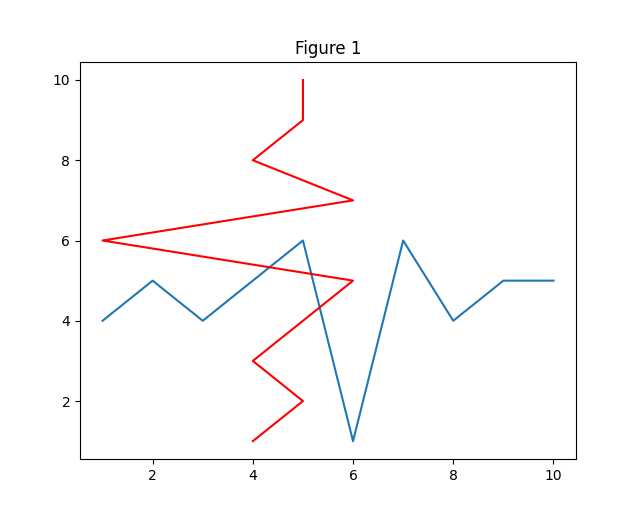
Here, the color can also be custom, just write the hex code of the color.
from matplotlib import pyplot as plt
x_axis = [1,2,3,4,5,6,7,8,9,10]
y_axis = [4,5,4,5,6,1,6,4,5,5]
plt.title(“Figure 2”)
# we can also control the shape and size of the intersections
plt.plot(y_axis,x_axis,marker=”*”, markersize=15)
# markers can be from ‘o’,’*’,’-’ and a few more
plt.show()
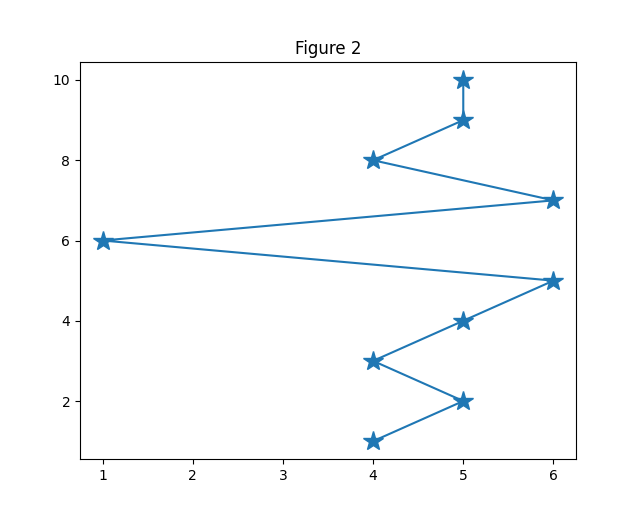
from matplotlib import pyplot as plt
x_axis = [1,2,3,4,5,6,7,8,9,10]
y_axis = [4,5,4,5,6,1,6,4,5,5]
plt.title(“Figure “)
# first we need to give the x and then y values
plt.plot(x_axis,y_axis, linestyle=”dotted”,linewidth=6)
# we can also change linetypes from [dotted, dashed, -, -., — .]
# and the line width
plt.show()

You can mix and match the above techniques to create something like this:
from matplotlib import pyplot as plt
# scale so the shape doesn’t expands, or contracts
plt.xlim(0.5,3.5)
plt.ylim(0,4)
# axis labels can also be given
plt.xlabel(“Length”)
plt.ylabel(“Height”)
# plot title
plt.title(“Alphabet M”)
x = [1,1]
y = [1,3]
plt.plot(x,y,color = ‘#cce85a’,lw=15)
plt.plot(x,y,’o’)
x = [1,1.5,2]
y = [3,2,3]
plt.plot(x,y,color = ‘#000000’,lw=10)
plt.plot(x,y,’*’)
x = [2,2]
y = [3,1]
plt.plot(x,y,color = ‘#809fff’,lw=15)
plt.plot(x,y,’+’)
plt.show()

Scatter Plots
You can imagine yourself using the plot function for data that is progressive. For example, if you try to plot irregular values in both the x and y axes, we might want to plot a Scatter plot, and what I mean by those values is we want to plot the point, not the indication of 2 points being connected progressively.
The parameters are the same, leaving out the line-related ones, of course.
from matplotlib import pyplot as plt
x = [2,3,1,2,1,2,3,5]
y = [1,2,3,5,1,2,3,5]
plt.scatter(x, y,color=’black’, alpha=0.8)
plt.show()
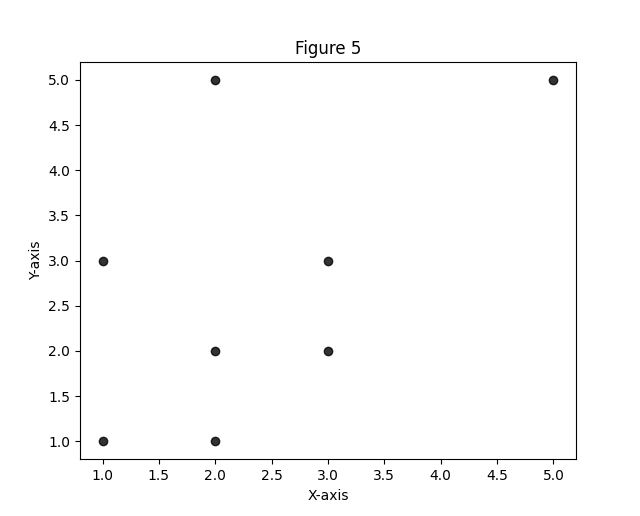
Bar Plots
These are used when you want to visualize the difference between the magnitude of different things belonging to the same group. We have labels on one axis,and any number plotted as a bar of some length on the other axis.
from matplotlib import pyplot as plt
import pandas as pd
names = [“Aman”,”Ashu”,”Anky”,”Ansh”]
heights = [167, 180, 177, 152]
plt.title(“Height Graph”)
plt.xlabel(“Names”)
plt.ylabel(“Height(in cms)”)
# first we need to pass in the labels and the values
# then the gap between the bars in percent
plt.bar(names, heights, 0.5, color=[“red”,”green”])
plt.show()

We can also switch the axes to make the bars horizontal and labels on the y-axis by using the barh function and instead, the parameters stay the same.
Histograms
When you want to see how data is distributed among a field, specifically the data frequencies separated on different ranges.
from matplotlib import pyplot as plt
import pandas as pd
# data = pd.read_csv(“../houses.csv”)
# data = data.dropna(axis=0)
# x = data[“total_sqft”]
x = [2,1,4,5,7,9,2,3,3,6,8,4,12]
# here bins parameter decides how many partitions are we going to do of our histogram
plt.hist(x,bins=4)
# now as the max value in x is 12, and bins is 4, so the 4 bars will display the frequencies from 1–3,4–6,7–9,10–12
plt.show()
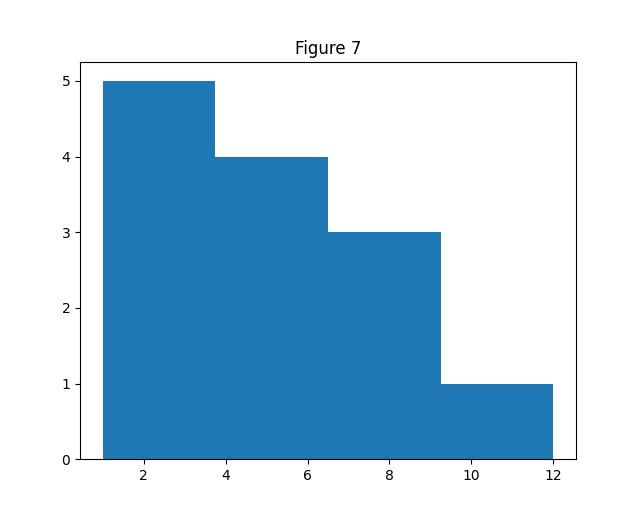
To get custom ranges, we can pass in a list of the ranges in bins instead
E.g., to achieve the same, we will put bins = [1,3,6,9,12]
Pie Charts
When you want to compare ratios of a field, or simply look at the weighing of data.
from matplotlib import pyplot as plt
import numpy as np
values = np.array([31,5,22,25,17,83,95,47,12,49,62,50])
avg = values.mean()
higher = 0
lower = 0
for i in values:
if i > avg:
higher += 1
else:
lower += 1
# first we pass in the list of values we want to compare, then the labels of those values
# explode means how out of the pie a part is going to be
plt.pie([higher,lower],labels=[“Greater”,”Lesser”], colors=[“red”,”green”], explode = [0.3,0])
plt.show()
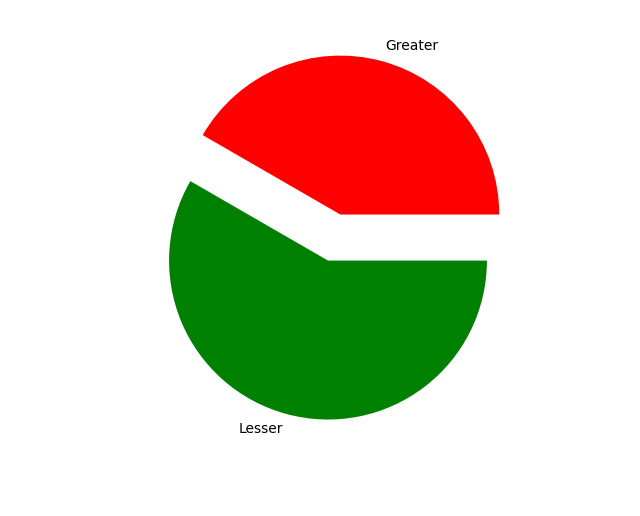
We still have many different types of graphs we can plot, but the introduction of the most popular way of data representation is complete.
Subplots
You can plot multiple plots as part of the same plot, using something called a subplot, first you need to describe the shape of the canvas and then the positioning of the specific subplots on that canvas.
The subplots can be of different types.
from matplotlib import pyplot as plt
x = [1,2,3,4]
y = [4,3,2,1]
z = [2]*4
# the shape we’ll pass in is 2,2 so the sublots will be structured like:
# [
# [[1],[2]],
# [[3],[4]]
# ]
plt.subplot(2,2,1)
plt.title(“First”)
plt.plot(x,y)
plt.subplot(2,2,4)
plt.title(“Second”)
plt.plot(x,x, linestyle=”dashed”)
plt.subplot(2,2,3)
plt.title(“Third”)
plt.plot(x,z, color=”hotpink”)
plt.subplot(2,2,2)
plt.title(“Fourth”)
plt.plot(z,z,marker=”*”)
plt.show()
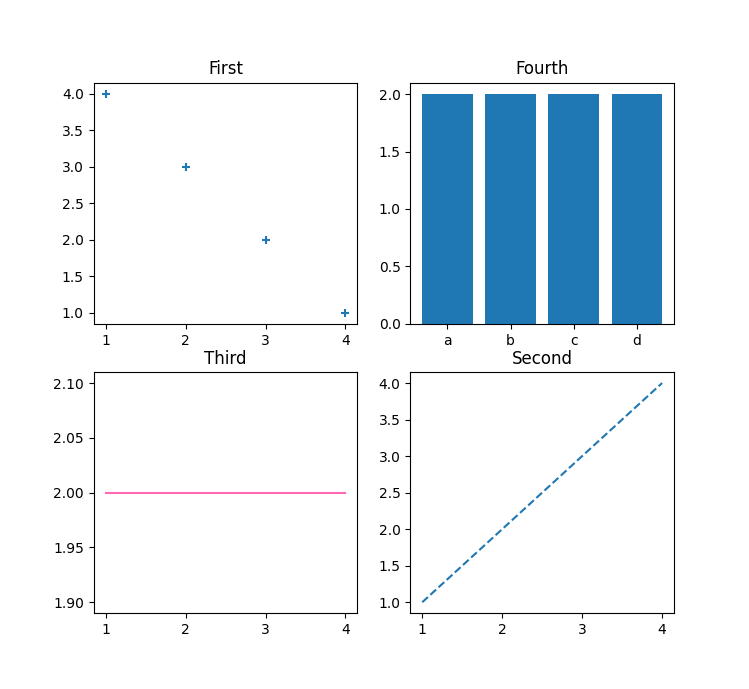
Conclusion
Matplotlib is a great tool depending on how much effort you are ready to put into work.
We learned how to create all the basic graphs, line plots, scatter plots, bar plots, histograms, pie charts and had an intuition of where we might prefer one over the other.
You are free to go and mix and match the function arguments and different graphs on the subplots, try out different values and labels.
The more you experiment, the more you’ll learn.
Resources
- Get link
- X
- Other Apps
Comments
Post a Comment